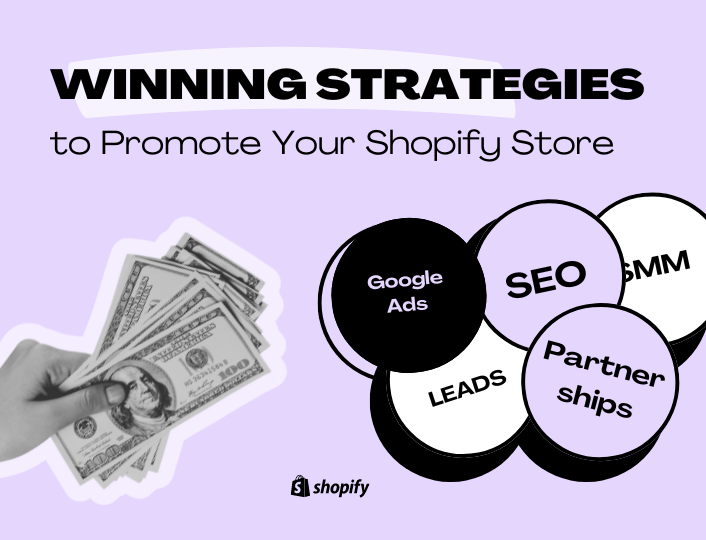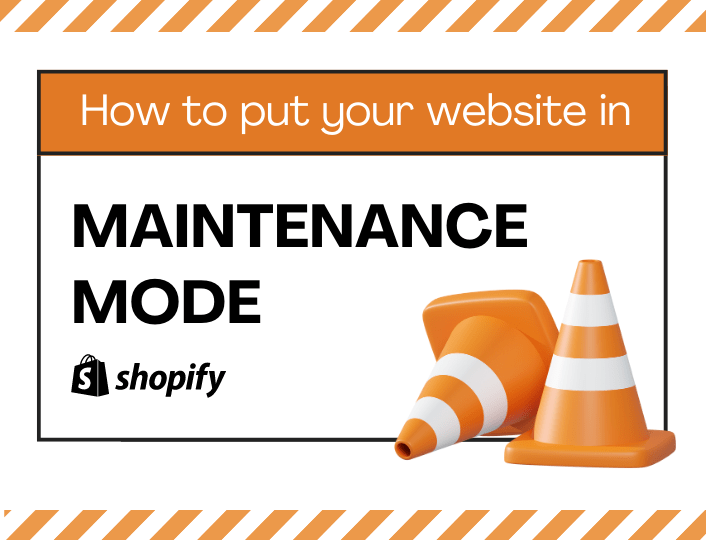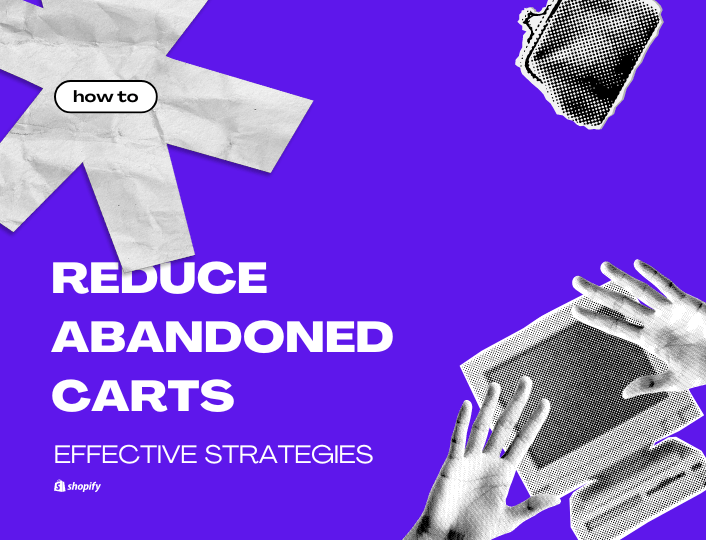Many Shopify sellers – new or existing – struggle to promote their stores? Why? You have to understand digital marketing, figure out how to stand out amongst competitors, how to show up in search, and how to connect with brand advocates. and build a fanbase.
The success rate of Shopify stores ranges between 5% to 10%. This shows that only 5-10 of 100 Shopify businesses become and stay successful. Given this, knowing and implementing the right strategies will help you promote your Shopify store and notch up sales.
In this article, we break down the strategies to help you prevent struggles with store promotion. They are:
- Optimize your store for search
- Leverage Influencer Marketing
- Maximize Social Media Marketing
- Distribute Email Campaigns
- Use Conversion Apps
- Market with Google Ads
- Create Multiple Content Channels
- Consider Partnerships and Collaborations
- Set Pre-Launch Marketing
- Create Awareness with Push Notifications
Best Strategies to Promote a Shopify Store
Digging into Shopify store promotion, you’d find more than a dozen strategies to change your sales experience. The nine strategies covered below are only a tested sample.
Bonus point: real-world businesses have implemented them to remarkable degrees of success.
Optimize Your Store for Search
When last did you hit a search on Google? If your answer is “anytime in the last 24 hours”, then that confirms something: Google search isn’t outdated. Google accounts for more than 90% of the global search volume.
For your business success, you need to cash in on search engine optimization. Your website should rank as high as possible, and should outrank competitors so buyers can easily find you. This won’t happen overnight, but once you start getting results with these tips you can continue to scale towards growth.
Create a Content Strategy
Customers search using a specific set of words; these are called keywords. When setting up your website, add relevant keywords to your pages. However, before you can do this, you need to map out a content strategy, find the right keywords that match buyers’ search intent and fit into your strategy, and ideate your content.
You can self-create these content strategies or work with resources like Hubspot’s Content Strategy template. The template shows you how to generate content ideas, create topical clusters, and repurpose your content.
Create Collection Pages
Creating collection pages is essential because high search volume keywords often target collections rather than individual products. For example, users searching for “bamboo plates for kids” prefer seeing a variety of options rather than a single item. By grouping similar products, such as green bamboo plates, small bamboo plates for babies, or award-winning bamboo plates, you can use the same products in different groupings. This allows you to create multiple collection pages, each targeting different keywords, enhancing your site’s SEO. This approach not only meets user demand but also increases your visibility across various search queries.
For the keyword “online wedding ring stores”, Azarai optimized their engagement ring page, increasing the chances of converting prospects.
Add Relevant Keywords to Products
Once you have a content strategy, you can distribute keywords on your product collection pages. Optimizing your product pages makes it easier for Google to rank your products, increasing organic traffic to your store. Repeat the same with your product captions, meta descriptions, etc.
Dreams, UK’s leading bed store, optimized a product page to match the keyword intent “Erin bunk bed”, resulting in the product page claiming the top spot in search engine results.
Start a Blog
When setting out, you may not have the resources to set up a blog. Once you can, start one. A blog gives you an avenue to target relevant informational keywords, share user stories and experiences, compile case studies, provide solutions to potential customers, and demonstrate expertise in your industry or market. RetroSupply Co and Dollar Shave Club are two examples worth considering.
With a blog, you can target relevant keywords matching your buyers’ search intent. For instance, if you sell kids’ beds, you can create blog topical clusters like:
- How to choose a kids’ bed (providing a step-wise guide and likely converting to a sale).
- Best materials for kids’ bed frames (where you can also establish niche or market expertise).
- Bunk beds vs high sleeper beds (with recommendations, also likely converting).
This way, you build topical authority and can also add internal links to your product collection pages. This creates high topical relevance.
Optimize Technical SEO
Non-content SEO also affects your website’s performance in search. For example, your website’s loading speed influences the bounce rate. Research indicates that two seconds is a good loading time for desktop, while the average loading time on mobile is 8.6 seconds.
Other technical SEO elements to cover on your website include:
- Crawling and indexing.
- Adding Structured data.
- Including internal links.
- Fixing broken links and crawl errors, etc
Link Building
Link building helps improve your site’s authority and ranking on search engine results pages (SERPs). By acquiring high-quality backlinks from reputable websites, you signal to search engines that your content is valuable and trustworthy. According to a study by Backlinko, websites in the top position on Google have an average of 3.8 times more backlinks than those in positions two through ten. For example, an online clothing store might collaborate with fashion bloggers to feature their products, gaining backlinks that enhance their search visibility.
Effective link-building strategies include:
- Guest blogging
- Link Insertions
- Influenecer outreach
- Leveraging unlinked brand mentions
- Broken link building
- Resource link building
- Digital PR for link building
- Influencer partnerships with industry leaders to get mentioned in industry news can also provide valuable backlinks.
Moz reports that link signals are one of the top-ranking factors for search engines. You need a robust backlink profile.
Leverage Influencer Marketing
The biggest challenge to using influencer marketing on Shopify is finding the right influencers – the right fit. While there are too many influencers with respectable social media following, not all of them can or will influence your target audience.
One way to solve this is to use influencer platforms like Shopify Collabs or UpFluence. These platforms make it easy to find influencers that understand your goals and align with your market, covering everything from creator management to brand ambassador collaborations.
Having matched the right influencer, you can execute several campaign types such as sponsored blog posts, social media mentions or collab posts (for example, Instagram co-posting), or influencer takeovers.
Next:
- Collaborate on Content: It’s good when your influencers create the content to market your product or store. It’s better when you collaborate on this. This lets you cross-check message intent, include clear call-to-actions, and maintain brand tone or voice.
- Track Marketing Results: Define your KPIs from the get-go. Communicate this to the influencers you work with to avoid ambiguity. Check for engagement level, conversion rates, increase in sales or subscribers, etc.
You can identify influencers that favor your brand – judging by the results – and then repeat processes with them to better your store promotion.
Gymshark does this by collaborating with athletes who post content featuring their products. Some also go as far as including captions detailing their experience with Gymshark.
Maximize Social Media Marketing
As with influencer marketing, you can promote your Shopify store with social media marketing. Once you’ve locked down your brand voice and identified your target audience, start creating and distributing relevant content on your social media platforms.
Warby Parker, the eyewear brand, runs a pristine social media marketing, distributing content across multiple platforms. Their posts are often a mix of problem-solving, humor, and expert insights.
For effective social media marketing:
- Provide value: Don’t market just because you want to market. Teach or remind your audience about something (in Warby’s tweet above, they emphasize that you don’t need to wear contacts in the shower, using a bit of humor). Here’s why to plug in the link to your blog if you have one.
- Use high-res visuals: Instagram, TikTok, and YouTube are visual-driven platforms. The clearer your product images, the better. Go all in with your visual marketing. Pair up your products with high-resolution images that depict exactly what customers should expect when they order. Then include descriptions to shopping these products from your store.
Warby Parker demoing one of their eyeglasses
- Build customer interaction: Engage your audience via comments and DMs. Answer questions, give clarity where necessary, and provide feedback. This warms the relationship and keeps your store top of mind.
- Link your well-performing social media posts to your product pages to maximize the engagement. You can also boost these posts with ads to increase their reach and visibility
Find more tips on growing with social media marketing here.
Distribute Email Campaigns
Email marketing is integral to business growth. Nine in ten users check their emails everyday, and 59% of buyers admit that emails have previously impacted their purchase decision. Email marketing converts even more than social media marketing, with 9 in 10 marketers using emails as the primary method for generating leads.
To maximize email marketing:
Set Up Email Popups
Create email popups with popup apps like Adoric. You can explore a range of email templates that lets you capture your buyers’ emails and build an email list.
Want to gather email leads while still providing your customers with value? Create a free gift email popup that offers a lead magnet once your customer submits their email information.
Share Timely Deals via Email
Launching a new product or restocking on a bestselling product? Offer your buyers the option to get notified via email. If you’re running a discount or promo, or planning a seasonal or anniversary sale, distributing emails to your subscribers converts seven times more than normal emails would.
Repurpose Blog Content via Email
Your buyers, like you, are busy individuals. So provide value to them by sharing links to your published content – blog and social media. Include a crisp call-to-action so they know what awaits them. The more they engage with your content, the more likely they are to turn to your store when they need what you offer.
Use Conversion Apps
Conversion apps improve your prospect:buyer ratio. The industry benchmark lists 1.5 – 2% as a good conversion rate. To meet or surpass this mark, use a conversion app like Adoric. Here’s how Adoric helps you improve your conversions
Personalized Product Recommendations
Adoric uses AI-powered insights to deliver tailored campaigns that match each customers’ needs. You can set these campaigns as in-page displays, popup displays, or slider displays. This determines how your customers interact with your custom offerings.
(note: some campaign types are subject to your store meeting the necessary requirements)
Special Offers
Want to speed up your time-to-sellout? You can package special offers and set them live with Adoric’s promotion tools.
You can create regular promotion popups offering a discount, or hang a floating bar with the best deals on your user’s screen. These let you sell more products.
Store Gamification
Gamify your shoppers’ experience with the falling gift and spin-the-wheel games. These short-span games reward participants with discounts and unique offers upon completing a round. This is a good strategy to convert first-time visitors to buyers and buyers to frequent buyers.
Adoric also offers specific email features for building an email list (discussed above). To learn more about increasing Shopify conversion with Adoric, click this guide.
Market with Google Ads
Google Ads offer precise targeting similar to social media ads. Here are some detailed strategies to enhance your Google Ads campaigns:
- Match Your Ad Copy with Your Store’s Content: Ensure consistency between your ad text and landing page content. For instance, if you advertise “handmade leather bags,” the landing page should feature those products prominently.
- Include Negative Keywords: Use negative keywords to exclude unrelated searches. For example, if you sell luxury watches, you might use “cheap” as a negative keyword to avoid clicks from budget shoppers.
- Focus on Long-Tail Keywords: Long-tail keywords like “organic cotton baby clothes” attract customers with specific buying intent (ready to purchase), often resulting in higher conversion rates.
- Maximize Assets: Utilize ad extensions to provide additional information and increase visibility. Use site links, callouts, and structured snippets to enhance your ad’s performance.
These tips will help you maximize your Google ads towards awareness and sales.
Create Multiple Content Channels.
Why stick with one when you can create three, four, or more content channels? It’s proven that seven in ten customers prefer to hop across channels before committing to a purchase. And these customers spend at least 10% more per purchase than the average buyer.
Create content across Twitter and Instagram. Repurpose your Instagram reels into TikTok posts and YouTube shorts. Combine two or more tweets into a Facebook or LinkedIn post. For effective omnichannel content distribution:
- Maintain brand voice: Your audience should receive the same “vibe” across your content channels. Use similar visuals on platforms that favor images and videos. Recycle your call-to-actions from newsletters to tweets. Reflect your brand colors on your website’s landing page, your social media banners, etc.
- Promote store content: When distributing content, don’t be modest with the frequency of promotions. You don’t always have to post about your products, but customers should get a good feel of what you sell and who you sell to when they leave any of your pages.
Twiice Boutique, a modern Australian fashion brand who converts with Adoric, keeps the same brand consistency on YouTube, Instagram and website. It’s easy to see that both images – though on different platforms – speak of the same brand.
Consider Partnerships and Collaboration
Collaborating with businesses that share mutual interests can be a powerful way to increase awareness for your Shopify store. Online partnerships, such as co-hosting webinars or cross-promotions on social media, can introduce your brand to new audiences. Offline collaborations, like joint events or pop-up shops, can also attract potential customers.
However, it’s important to note that this approach may not be the best route for new Shopify sellers. Established businesses typically seek partnerships that offer clear mutual benefits. As a new seller, you might find more success in building a strong brand and customer base before pursuing significant collaborations.
Set Pre-Launch Marketing
In 2012, the Dollar Shave Club disrupted the men’s care and shaving market with a pre-launch marketing ad. In the video, the CEO delivered a nonchalant monologue about the brand’s aim – to give buyers better quality at a $1 price, far below what was considered the average price.
The video, captioned “Our Blades Are F**king Great”, was the most non-adsy ad at the time. Did it work? Yes, prompting over 12,000 orders within a two-day span. The video currently sits at 28M views on YouTube.
A pre-launch marketing app can make all the difference between a brand that sticks and one that’s soon forgotten. To get your pre-launch strategy right:
- Create Anticipation with Teasers. Use cryptic messages, intriguing visuals, and short videos that hint at your product without revealing too much. This builds curiosity and anticipation among your audience.
- Personalized Engagement: Focus on personalized interactions with your potential customers. Use direct messages, personalized emails, and exclusive invites to make them feel valued and part of an inner circle.
- Craft a compelling story around your product’s journey, the problem it solves, and its unique features. Some behind-the-scenes content and founder stories can create a deeper connection with your audience.
- Test the market. This lets you ensure the timing is right, the buyers are ready, and your prices aren’t marked up (and if they are, the buyers willing to trade the added price for extra value). Sample a small group and A/B test your products or services. Lack of market research is a contributing factor to most failed product launches.
Explore the best way to pre-launch in 2024 here.
Create Awareness with Push Notifications
Only a small portion of visitors coming to your website will purchase at any given time. You can nurture customers’ interests with push notifications (see example below)
Push notifications offer multiple uses. For example, you can entice new visitors with a discount. You can also leverage it to remind shoppers about their uncompleted carts and products they viewed but never purchased. Creating push notifications that encourage purchase checkouts is easy with Adoric.
For example, you can remind customers about their cart items before they leave. This is displayed as a pop-up to customers before they leave your store. It acts as a reminder to complete their purchases.
With push notifications, you can promote your Shopify store, win back potential customers and boost your sales.
Expert Summary
“As a company committed to helping our customers convert more customers, we understand the importance of creating awareness through store promotions. We’re constantly investing in our content strategy and marketing with commensurate results. The strategies covered in this article are precise and helpful for Shopify sellers looking to promote their Shopify stores.” – Tal Revivo, CEO, Adoric.
Conclusion
The strategies covered in this article are a good start to promoting your Shopify store. They also confirm one thing: you don’t need to step out of your budget to hack Shopify store promotion.
You can simply start with what you have – a blog page, an email list, a camera for creating video clips and high-res pictures. Shopify store promotion is ultimately about knowing what you offer, knowing who needs your products, and positioning your brand before them.
Want to get more results with Shopify store promotion? Partner with Adoric. With only $5, you can join 3000+ Shopify merchants who create high-converting campaigns with Adoric. Click the link below to get started.
Discover more Shopify resources below:





